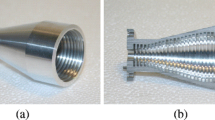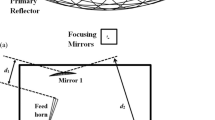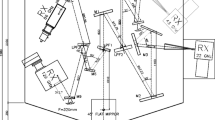Abstract
The Atacama Large Millimeter/Sub-millimeter Array (ALMA) is currently the largest (sub-)mm wave telescope in the world and will be used for astronomical observations in all atmospheric windows from 35 to 950 GHz when completed. The ALMA band 1 (35–50 GHz) receiver will be used for the longest wavelength observations with ALMA. Because of the longer wavelength, the size of optics and waveguide components will be larger than for other ALMA bands. In addition, all components will be placed inside the ALMA cryostat in each antenna, which will impose severe mechanical constraints on the size and position of receiver optics components. Due to these constraints, the designs of the corrugated feed horn and lens optics are highly optimized to comply with the stringent ALMA optical requirements. In this paper, we perform several tolerance analyses to check the impact of fabrication errors in such an optimized design. Secondly, we analyze the effects of operating this optics inside the ALMA cryostat, in particular the effects of having the cryostat IR filters placed next to the band 1 feed horn aperture, with the consequent near-field effects. Finally, we report on beam measurements performed on the first three ALMA band 1 receivers inside test cryostats, which satisfy ALMA specifications. In these measurements, we can clearly observe the effects of fabrication tolerances and IR filter effects on prototype receiver performance.



















Similar content being viewed by others
References
A. Wootten, and A. Thompson, “The Atacama Large Millimeter/Submillimeter Array,” Proceedings of the IEEE, vol.97, 1463 (2009)
Y-J. Hwang, et al., “Band 1 receiver front-end cartridges for Atacama Large Millimeter/submillimeter Array (ALMA): design and development toward production”, SPIE conference on Astronomical Telescopes + Instrumentation 2016 (2016)
N. Reyes, et al., “Design of the optical system for ALMA Band 1,” in Proceedings of SPIE Vol. 9145, p. 91451W (2014)
A. Gonzalez, et al., “Alternative optics design for the ALMA Band 1 receiver (35–52 GHz),” in European Conference on Antennas and Propagation (EuCAP), pp. 1–4 (2015).
V. Tapia, et al., “High Efficiency Wideband Refractive Optics for ALMA Band-1 (35-52 GHz)”, Journal of Infrared, Millimeter, and Terahertz Waves, Vol. 38, Issue 3, pp. 261–275 (2017)
J. M. Hammersly and D. C. Handscomb, Monte Carlo Methods. New York: Wiley, 1964.
A. Gonzalez, and Y. Uzawa, “Tolerance Analysis of ALMA Band 10 Corrugated Horns and Optics”, IEEE Transactions on Antennas and Propagation, Vol. 60, No. 7, pp. 3137–3145, 2012
A. Hammar, M. Whale, P. Forsberg, A. Murk, A. Emrich, and J. Stake, “Optical Tolerance Analysis of the Multi-Beam Limb Viewing Instrument STEAMR”, IEEE Transactions on Terahertz Science and Technology, Vol. 4, No. 6, pp. 714–721, 2014
M. Candotti, Y. Uzawa, S. V. Shitov, Y. Fujii, and K. Kaneko, “ALMA band 10 optics tolerance analysis,” in Proc. 19th Int. Symp. on Space THz Technol., Groningen, The Netherlands, 2008, pp. 521–527
MIG WASP-NET, software description. Available: http://www.mig-germany.com/
MathWorks MATLAB, software description. Available: https://www.mathworks.com/products/matlab.html
A. Gonzalez, S. Asayama, V. Tapia, R. Finger, D. Monasterio and N. Reyes, "Effects of cryostat infrared filters on the performance of ALMA band 1 (35–52 GHz) receiver optics," 2016 I.E. International Symposium on Antennas and Propagation (APS-URSI), Fajardo, 2016, pp. 381–382
A. Gonzalez, and Y. Uzawa, “Investigation on ALMA Band-4 Frequency-Dependent Cross-Polarization”, IEEE Transactions on Terahertz Science and Technology, Vol. 4, Issue 2, pp.184–192 (2014)
ANSYS HFSS, software description. Available: http://www.ansys.com/products/electronics/ansys-hfss
D. Slater, Near-Field Antenna Measurements. Norwood: Artech House, 1991
Author information
Authors and Affiliations
Corresponding author
Rights and permissions
About this article
Cite this article
Gonzalez, A..., Tapia, V., Finger, R. et al. ALMA Band 1 Optics (35–50 GHz): Tolerance Analysis, Effect of Cryostat Infrared Filters and Cold Beam Measurements. J Infrared Milli Terahz Waves 38, 1215–1231 (2017). https://doi.org/10.1007/s10762-017-0414-x
Received:
Accepted:
Published:
Issue Date:
DOI: https://doi.org/10.1007/s10762-017-0414-x




